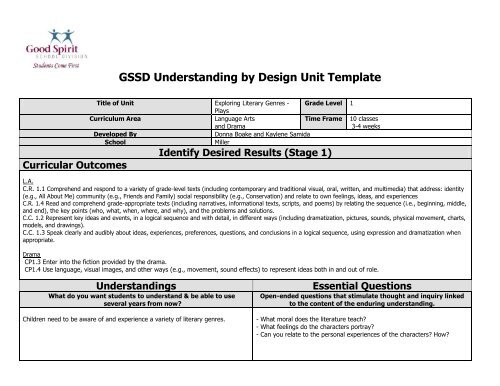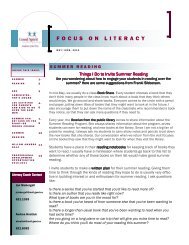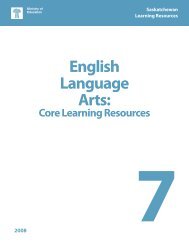Understanding By Design Unit Template - GSSD Blogs
Understanding By Design Unit Template - GSSD Blogs
Understanding By Design Unit Template - GSSD Blogs
- No tags were found...
You also want an ePaper? Increase the reach of your titles
YUMPU automatically turns print PDFs into web optimized ePapers that Google loves.
<strong>GSSD</strong> <strong>Understanding</strong> by <strong>Design</strong> <strong>Unit</strong> <strong>Template</strong>Curricular OutcomesTitle of <strong>Unit</strong> Exploring Literary Genres - Grade Level 1PlaysCurriculum AreaLanguage Artsand DramaTime Frame 10 classes3-4 weeksDeveloped <strong>By</strong>Donna Boake and Kaylene SamidaSchoolMillerIdentify Desired Results (Stage 1)L.A.C.R. 1.1 Comprehend and respond to a variety of grade-level texts (including contemporary and traditional visual, oral, written, and multimedia) that address: identity(e.g., All About Me) community (e.g., Friends and Family) social responsibility (e.g., Conservation) and relate to own feelings, ideas, and experiencesC.R. 1.4 Read and comprehend grade-appropriate texts (including narratives, informational texts, scripts, and poems) by relating the sequence (i.e., beginning, middle,and end), the key points (who, what, when, where, and why), and the problems and solutions.C.C. 1.2 Represent key ideas and events, in a logical sequence and with detail, in different ways (including dramatization, pictures, sounds, physical movement, charts,models, and drawings).C.C. 1.3 Speak clearly and audibly about ideas, experiences, preferences, questions, and conclusions in a logical sequence, using expression and dramatization whenappropriate.DramaCP1.3 Enter into the fiction provided by the drama.CP1.4 Use language, visual images, and other ways (e.g., movement, sound effects) to represent ideas both in and out of role.<strong>Understanding</strong>sWhat do you want students to understand & be able to useseveral years from now?Children need to be aware of and experience a variety of literary genres.Essential QuestionsOpen-ended questions that stimulate thought and inquiry linkedto the content of the enduring understanding.- What moral does the literature teach?- What feelings do the characters portray?- Can you relate to the personal experiences of the characters? How?
KnowledgeStudents will know…SkillsStudents will be able to…C.C.1.2 Represent key ideas and events, in a logical sequence and with detail, indifferent ways (including dramatization, pictures, sounds, physical movement,charts, models, and drawings).C.C.1.3 Speak clearly and audibly about ideas, experiences, preferences,questions, and conclusions in a logical sequence, using expression anddramatization when appropriate.C.R.1.4 Read and comprehend grade-appropriate texts (including narratives,informational texts, scripts, and poems) by relating the sequence (i.e.,beginning, middle, and end), the key points (who, what, when, where, andwhy), and the problems and solutions.C.R.1.1 Comprehend and respond to a variety of grade-level texts (includingcontemporary and traditional visual, oral, written, and multimedia) that address:identity (e.g., All About Me) community (e.g., Friends and Family) socialresponsibility (e.g., Conservation) and relate to own feelings, ideas, andexperiencesC.P.1.3 Enter into the fiction provided by the drama.C.P.1.4 Use language, visual images, and other ways (e.g., movement, soundeffects) to represent ideas both in and out of role.Dramatize a story (e.g., a traditional First Nations, Métis, or Inuit story).Rehearse and deliver brief short poems, rhymes, songs, stories (includingcontemporary and traditional First Nations, Métis, and Inuit poems andstories) or lines from a play and oral presentations about familiarexperiences or interests.Identify the sequence of a text and respond to who, what, when, where,why, and how questions.Relate aspects of stories and characters from various texts to personalfeelings and experiences.Describe characters, the way they might feel, and the way situations mightcause them to feel.Contribute ideas to the drama.Collaborate with others in dramatic contexts.Express ideas by speaking in role.
Assessment Evidence (Stage 2)Performance Task DescriptionThe PERFORMANCE TASK describes the learning activity in “story” form. Typically, the P.T. describes ascenario or situation that requires students to apply knowledge and skills to demonstrate theirunderstanding in a real life situation. Describe your performance task scenario below:You and your classmates will read, practice, and perform the story drama “The Little Red Hen”. Roles will be assigned forspeaking parts, set design, and other supporting roles. You will need to assume the roles of the story characters andeffectively display their feelings. You will be responsible for performing this story drama in front of an audience.RolesNarratorLittle Red HenCatDogPigMouseDuckArt DirectorStage <strong>Design</strong>er (Puppet Theatre)Prop CreatorsHelpful tips for writing aperformance task.Goal:What should studentsaccomplish by completingthis task?Role:What role (perspective)will your students betaking?Audience:Who is the relevantaudience?Situation:The context or challengeprovided to the student.Product/Performance:What product/performancewill the student create?Standards(Create the rubric for thePerformance Task)
BLOOMS TAXONOMY:REMEMBERING: Can the students recall or remember the information?UNDERSTANDING: Can the students explain ideas or concepts?APPLYING: Can the students use the information in a new way?ANALYZING: Can the students distinguish between the different parts?EVALUATING: Can the students justify a stand or decision?CREATING: Can the students create new product or point of view?Digital Taxonomy for Bloom:KNOWLEDGE: Highlighting, bookmarking, social networking, searching, googlingCOMPREHENSION: Advanced searches, blog journaling, twittering, commentingAPPLICATION: Running, loading, playing, operating, hacking, uploading, sharing, editingANALYSIS: Mashing, linking, tagging, validating, cracking, reverse-engineeringSYNTHESIS: Programming, filming, animating, blogging, wiki-ing, publishing, podcasting,video castingEVALUATION: Blog commenting, reviewing, posting, moderating, collaborating,networking, posting moderatingOther Assessment Evidence: (Formative and summative assessments used throughout the unit to arrive at the outcomes.)Conversation Observation ProductDiscussionsChecklistsSelf-AssessmentAnecdotal RecordsRubric – Performance TaskJournalLearning Plan (Stage 3)Where are your students headed? Where have they been? How will you make sure the students know where they are going?- Students are headed towards more in depth understanding of speaking behaviours through dramatization.- Students have experienced opportunities of role plays and listening to a variety of literary texts.- Students will be informed of the unit of study, expectations, and overview of rubric.How will you hook students at the beginning of the unit? (motivational set)- Engage students in a modeling act of a similar story.What events will help students experience and explore the enduring understandings and essential questions in the unit? How will youequip them with needed skills and knowledge? How will you organize and sequence the learning activities to optimize the engagement andachievement of all students? Part 1- Motivational Set: Model a short play or portion of.- Discussion and questions.- KWL: Characteristics of a play.Time Frame1 Class(50 minutes) Part 2- Picture walk of the story. (The Little Red Hen)- Reading of the story. (The Little Red Hen)- Discussion of moral/lesson of the story.- Sequencing activity and 5 W’s.2 Classes
- Introduce another story, read it, and do comparisons. Use graphic organizer or Venn Diagram to look at similarities anddifferences. May have to revisit first story (The Little Red Hen) to do comparisons. Discuss personal connections and morals/lessons. Part 3- Model proper public speaking.- Provide opportunities for students to practice speaking in small groups using various speaking activities. (Ex: Story circle, Story in abox) Part 4- Assign students roles and characters for the play. (The Little Red Hen)- Students will practice reading their parts.- Create props, stage designs, and puppets.- Continue practice/review until performance date. Part 5- The performance to another class of students in the school.- Students will do a self-assessment upon completion.1 Class5 Classes1 ClassHow will you cause students to reflect and rethink? How will you guide them in rehearsing, revising, and refining their work based on youressential questions and enduring understandings?- Self-assessments, Checklists, Modeling, Practice, Journals.How will you help students to exhibit and self-evaluate their growing skills, knowledge, and understanding throughout the unit?- Review of rubric with students- Self-assessments- Conversations and discussionsHow will you tailor and otherwise personalize the learning plan to optimize the engagement and effectiveness of ALL students, withoutcompromising the goals of the unit?- Leveled versions of text- Audio and video versions- Graphic organizer- Scribe- Provide students with activities and roles that address their strengths and interestsWhat resources will you use in the learning experiences to meet the outcomes?- Language Arts Curriculum- Arts Education Curriculum- Journey’s: A Bear With Electric Hair – Little Red Hen Play- Audio version of The Little Red Hen
- Video version of The Little Red Hen- Various fables- Aesop for Children- The Tortoise and The Hare- The Little Red HenAssess and Reflect (Stage 4)Required Areas of Study:Is there alignment between outcomes, performance assessment and learning experiences?Broad Areas of Learning:Does my unit promote life long learning, encourage the development of self and community, and engage students?CELS & CCC’s:Do the learning experiences allow learners to use multiple literacies while constructing knowledge, demonstrating socialresponsibility, and acting autonomously in their world?Adaptive Dimension/Differentiated Instruction:Have I made purposeful adjustments to the curriculum content (not outcomes), instructional practices, and/or the learningenvironment to meet the learning needs of all my students?Instructional Approaches:Do I use a variety of teacher directed and student centered instructional approaches?Student Evaluation:Have I included formative and summative assessments reflective of student needs and interests based on curricularoutcomes?Resources:Do the students have access to various resources on an ongoing basis?FNM/I Content and Perspectives/Gender Equity/Multicultural Education:Have I nurtured and promoted diversity while honoring each child’s identity?Blueprint for Life (Grade 6-9):Have I planned learning experiences in the unit that prepare students for a balanced life and/or work career?Adapted from: Wiggins, Grant and J. McTighe. (1998). <strong>Understanding</strong> by <strong>Design</strong>, Association for Supervision and Curriculum Development.YesYesYesYesYesYesYesYes
RubricFor Actors/Actresses in Little Red Hen PlayUse ofSpace/ BodyMovementBeginning Satisfactory Proficient Excellent‣ Seldom uses whole body ‣ Sometimes uses whole bodyfreely – mainly moves freely.arms and legs.‣ Sometimes able to work with‣ Demonstrates little variety concepts of movement: space,while using space, body, body, time.time.‣ Sits or stands in thesame spot for durationof an activity thatencourages movement– shows littlelocomotion.‣ Does not demonstrateuse of space, body,and time.‣ Usually uses whole body freely.‣ Easily able to work creatively andfreely with concepts of movement:space, body, time.Verbal/VocalExpressionUse ofObjectsDramaticExpression‣ Little or no verbal orvocal response.‣ Does not incorporateuse of props.‣ Little or nodramaticexpression ofcharactersdisplayed.‣ Mumbles‣ Speaks without variety intone, pitch, and voicequality.‣ Hesitates to communicate.‣ Seldom incorporates useof props.‣ Seldom displaysdramatic expressionof characters.‣ Sometimes demonstratesvariety in volume, tone, pitch,and voice quality.‣ Communicates with somefluency.‣ Sometimes incorporates use ofprops.‣ Sometimes displaysdramatic expression ofcharacters.‣ Usually demonstrates variety involume, tone, pitch, and voicequality.‣ Communicates easily and fluently.‣ Incorporates use of props..‣ Usually displays dramaticexpressions of characters.Participation‣ Little or noparticipation.‣ Participates in someaspects but isinconsistent.‣ Participation isconsistent.‣ Participates in each part ofthe process. Andencourages others toparticipate.Comments:
RubricArt Directors, Set designers, and Prop CreatorsCreativeExpressionEffortParticipationBeginning Satisfactory Proficient Excellent‣ Contributes to one or two ‣ Contribution is consistent,aspects, but is inconsistent. and to most parts of the‣ Is inconsistent in focus and process; contribution istime on task.substantial.‣ Remains focused on task‣ Contribution is minimaland simple.‣ Scattered focus;distracts others.‣ Very little effort‣ Poor & unfinishedprojects‣ Little or noparticipation.‣ Inconsistent effort‣ Partially or barelyadequate completionof projects‣ Participates in someaspects but isinconsistent.most of the time.‣ Good effort‣ Generally completesprojects with care‣ Participation isconsistent.‣ Contributes to each part of theprocess, contributes meaningfullyin the group, encourages others tocontribute meaningfully.‣ Remains focused and stays ontask.‣ Makes a very good,consistent effort‣ Completes projectswith thoroughness‣ Participates in each partof the process. Andencourages others toparticipate.Comments:
















